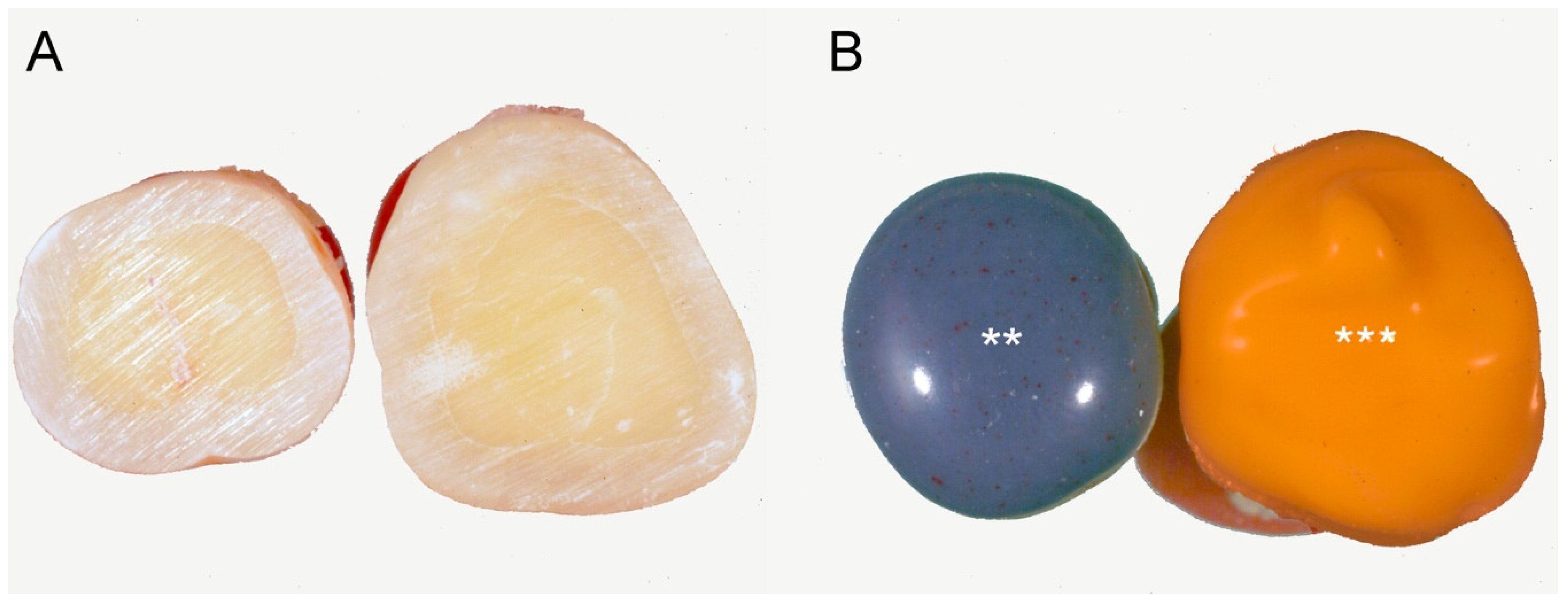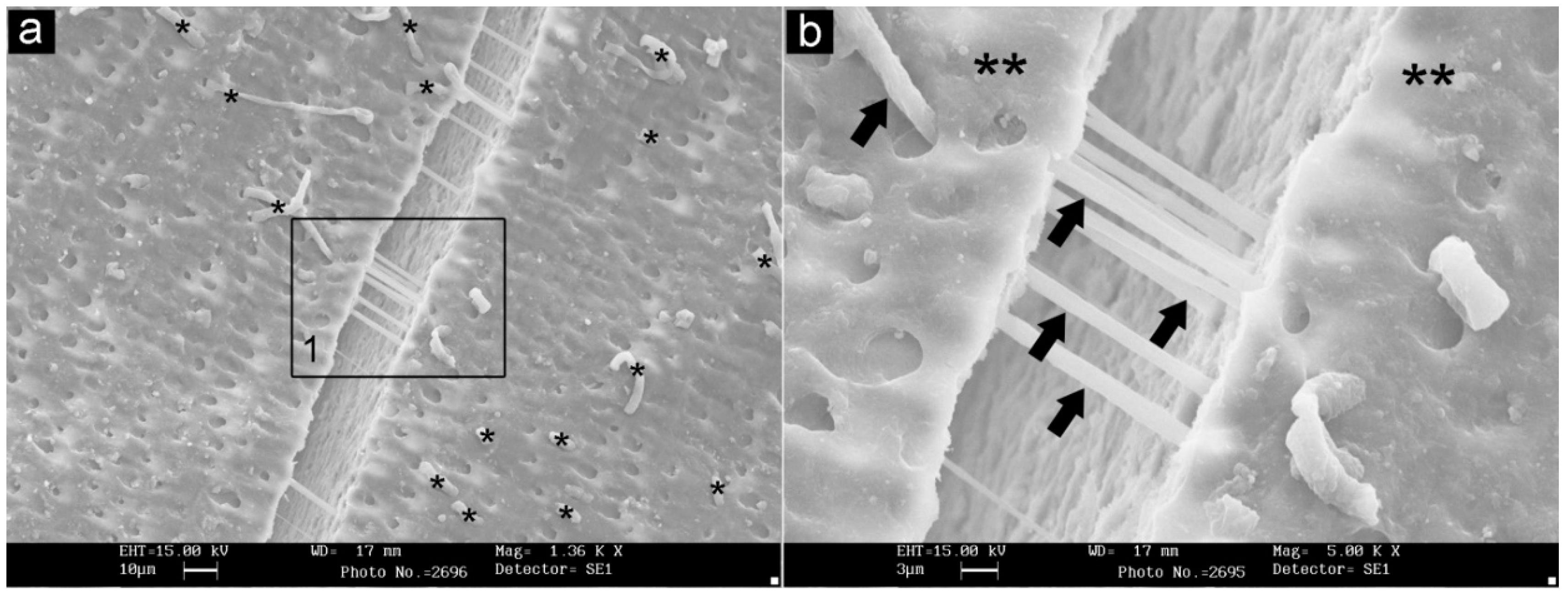Penetration of Different Impression Materials into Exposed Dentinal Tubules during the Impression Procedure
Abstract
1. Introduction
2. Materials and Methods
2.1. Study Sample
2.2. Sample Preparation
2.3. Variables Measured
2.4. Statistical Analysis
3. Results
4. Discussion
5. Conclusions
Author Contributions
Funding
Conflicts of Interest
References
- Bedran-Russo, A.; Leme-Kraus, A.A.; Vidal, C.M.P.; Teixeira, E.C. An overview of dental adhesive systems and the dynamic tooth-adhesive interface. Dent. Clin. N. Am. 2017, 61, 713–731. [Google Scholar] [CrossRef]
- Ferracane, J.L. Resin composite—State of the art. Dent. Mater. 2011, 27, 29–38. [Google Scholar] [CrossRef] [PubMed]
- Demarco, F.F.; Collares, K.; Coelho-de-Souza, F.H.; Correa, M.B.; Cenci, M.S.; Moraes, R.R.; Opdam, N.J. Anterior composite restorations: A systematic review on long-term survival and reasons for failure. Dent. Mater. 2015, 31, 1214–1224. [Google Scholar] [CrossRef] [PubMed]
- De Moura, F.R.R.; Romano, A.R.; Lund, R.G.; Piva, E.; Rodrigues, S.A., Jr.; Demarco, F.F. Three-year clinical performance of composite restorations placed by undergraduate dental students. Braz. Dent. J. 2011, 22, 111–116. [Google Scholar] [CrossRef] [PubMed]
- Correa, M.B.; Peres, M.A.; Peres, K.G.; Horta, B.L.; Barros, A.D.; Demarco, F.F. Amalgam or composite resin? Factors influencing the choice of restorative material. J. Dent. 2012, 40, 703–710. [Google Scholar] [CrossRef]
- Calamia, J.R. Etched porcelain facial veneers: A new treatment modality based on scientific and clinical evidence. N. Y. J. Dent. 1983, 53, 255–259. [Google Scholar]
- Traini, T.; Sinjari, B.; Pascetta, R.; Serafini, N.; Perfetti, G.; Trisi, P.; Caputi, S. The zirconia-reinforced lithium silicate ceramic: Lights and shadows of a new material. Dent. Mater. J. 2016, 35, 748–755. [Google Scholar] [CrossRef]
- Van den Breemer, C.R.; Gresnigt, M.M.; Cune, M.S. Cementation of glass-ceramic posterior restorations: A systematic review. Biomed. Res. Int. 2015, 2015, 148954. [Google Scholar] [CrossRef]
- Pjetursson, B.E.; Valente, N.A.; Strasding, M.; Zwahlen, M.; Liu, S.; Sailer, I. A systematic review of the survival and complication rates of zirconia-ceramic and metal-ceramic single crowns. Clin. Oral Implant. Res. 2018, 29 (Suppl. S16), 199–214. [Google Scholar] [CrossRef]
- Munaga, S.; Chitumalla, R.; Kubigiri, S.K.; Rawtiya, M.; Khan, S.; Sajjan, P. Effect of saliva contamination on the shear bond strength of a new self-etch adhesive system to dentin. J. Conserv. Dent. 2014, 17, 31–34. [Google Scholar] [CrossRef]
- Sailer, I.; Makarov, N.A.; Thoma, D.S.; Zwahlen, M.; Pjetursson, B.E. All-ceramic or metal-ceramic tooth-supported fixed dental prostheses (FDPs)? A systematic review of the survival and complication rates. Part I: Single crowns (SCs). Dent. Mater. 2015, 31, 603–623. [Google Scholar] [CrossRef] [PubMed]
- Edelhoff, D.; Ozcan, M. To what extent does the longevity of fixed dental prostheses depend on the function of the cement? Working Group 4 materials: Cementation. Clin. Oral Implant. Res. 2007, 18, 193–204. [Google Scholar] [CrossRef] [PubMed]
- D’Arcangelo, C.; De Angelis, F.; D’Amario, M.; Zazzeroni, S.; Ciampoli, C.; Caputi, S. The influence of luting systems on the microtensile bond strength of dentin to indirect resin-based composite and ceramic restorations. Oper. Dent. 2009, 34, 328–336. [Google Scholar] [CrossRef] [PubMed][Green Version]
- Powers, J.M.; Farah, J.W. Technique sensitivity in bonding to enamel and dentin. Compend. Contin. Educ. Dent. 2010, 31, 1–8. [Google Scholar]
- Kubo, S.; Kawasaki, A.; Hayashi, Y. Factors associated with the longevity of resin composite restorations. Dent. Mater. J. 2011, 30, 374–383. [Google Scholar] [CrossRef]
- Pashley, E.L.; Comer, R.W.; Simpson, M.D.; Horner, J.A.; Pashley, D.H.; Caughman, W.F. Dentin permeability: Sealing the dentin in crown preparations. Oper. Dent. 1992, 17, 13–20. [Google Scholar]
- Magne, P.; So, W.S.; Cascione, D. Immediate dentin sealing supports delayed restoration placement. J. Prosthet. Dent. 2007, 98, 166–174. [Google Scholar] [CrossRef]
- Magne, P.; Nielsen, B. Interactions between impression materials and immediate dentin sealing. J. Prosthet. Dent. 2009, 102, 298–305. [Google Scholar] [CrossRef]
- Magne, P. Immediate dentin sealing: A fundamental procedure for indirect bonded restorations. J. Esthet. Restor. Dent. 2005, 17, 144–154. [Google Scholar] [CrossRef]
- Rueggeberg, F.A.; Margeson, D.H. The effect of oxygen inhibition on an unfilled/ filled composite system. J. Dent. Res. 1990, 69, 1652–1658. [Google Scholar] [CrossRef]
- Erickson, R.L. Mechanism and clinical implications of bond formation for two dentin bonding agents. Am. J. Dent. 1989, 2, 117–223. [Google Scholar] [PubMed]
- Ghiggi, P.C.; Steiger, A.K.; Marcondes, M.L.; Mota, E.G.; Burnett, L.H.; Júnior Spohr, A.M. Does immediate dentin sealing influence the polymerization of impression materials? Eur. J. Dent. 2014, 8, 366–372. [Google Scholar] [CrossRef] [PubMed]
- Sinjari, B.; D’Addazio, G.; Murmura, G.; Di Vincenzo, G.; Semenza, M.; Caputi, S.; Traini, T. Avoidance of interaction between impression materials and tooth surface treated for immediate dentin sealing: An in-vitro study. Materials (Basel) 2019, 12, 3454. [Google Scholar] [CrossRef] [PubMed]
- Bergmann, P.; Noack, M.J.; Roulet, J.F. Marginal adaptation with glass-ceramic inlays adhesively luted with glycerine gel. Quintessence Int. 1991, 22, 739–744. [Google Scholar] [PubMed]
- Richardson, D.; Tao, L.; Pashley, D.H. Dentin permeability: Effects of crown preparation. Int. J. Prosthodont. 1991, 4, 219–225. [Google Scholar] [PubMed]
- Gijsbers, K.; Nicholson, F. Experimental pain thresholds influenced by sex of experimenter. Percept. Mot. Ski. 2005, 101, 803–807. [Google Scholar] [CrossRef]
- Faus-Matoses, I.; Solá-Ruiz, F. Dental preparation with sonic vs high-speed finishing: Analysis of microleakage in bonded veneer restorations. J. Adhes. Dent. 2014, 16, 29–34. [Google Scholar]
- Love, R.M.; Jenkinson, H.F. Invasion of dentinal tubules by oral bacteria. Crit. Rev. Oral Biol. Med. 2002, 13, 1711–1783. [Google Scholar] [CrossRef]
- Juneja, R.; Duhan, J.; Tewari, S.; Sangwan, P.; Bhatnagar, N. Effect of blood contamination and decontamination protocols on acetone-based and ethanol-based total etch adhesive systems. J. Esthet. Restor. Dent. 2014, 26, 403–416. [Google Scholar] [CrossRef]
- Kilic, K.; Arslan, S.; Demetoglu, G.A.; Zararsiz, G.; Kesim, B. Do blood contamination and haemostatic agents affect microtensile bond strength of dual cured resin cement to dentin? J. Appl. Oral Sci. 2013, 21, 85–91. [Google Scholar] [CrossRef]
- Magne, P.; Douglas, W.H. Porcelain veneers: Dentin bonding optimization and biomimetic recovery of the crown. Int. J. Prosthodont. 1999, 12, 111–121. [Google Scholar] [PubMed]
- Varvara, G.; Murmura, G.; Sinjari, B.; Cardelli, P.; Caputi, S. Evaluation of defects in surface detail for monophase, 2-phase, and 3-phase impression techniques: An in-vitro study. J. Prosthet. Dent. 2015, 113, 108–113. [Google Scholar] [CrossRef] [PubMed]
- Sinjari, B.; D’Addazio, G.; Bozzi, M.; Celletti, R.; Traini, T.; Mavriqi, L.; Caputi, S. Comparison of a novel ultrasonic scaler tip vs. conventional design on a titanium surface. Materials (Basel) 2018, 22, 2345. [Google Scholar] [CrossRef] [PubMed]
- Sinjari, B.; D’Addazio, G.; Bozzi, M.; Santilli, M.; Traini, T.; Murmura, G.; Caputi, S. SEM Analysis of enamel abrasion after air polishing treatment with erythritol, glycine and sodium bicarbonate. Coatings 2019, 9, 549. [Google Scholar] [CrossRef]
- D’Addazio, G.; Artese, L.; Traini, T.; Rubini, C.; Caputi, S.; Sinjari, B. Immunohistochemical study of osteopontin in oral squamous cell carcinoma allied to fractal dimension. J. Biol. Regul. Homeost. Agents 2018, 32, 1033–1038. [Google Scholar]
- Mancardi, D.; Varetto, G.; Bucci, E.; Maniero, F.; Guiot, C. Fractal parameters and vascular networks: Facts and artifacts. Theor. Biol. Med. Model. 2008, 5, 12. [Google Scholar] [CrossRef]
- Baish, J.W., Jr. Fractals and cancer. Cancer Res. 2000, 60, 3683–3688. [Google Scholar]
- Re, D.; De Angelis, F.; Augusti, G.; Augusti, D.; Caputi, S.; D’Amario, M.; D’Arcangelo, C. Mechanical properties of elastomeric impression materials: An in-vitro comparison. Int. J. Dent. 2015, 2015, 428286. [Google Scholar] [CrossRef]
- Hamalian, T.A.; Nasr, E.; Chidiac, J.J. Impression materials in fixed prosthodontics: Influence of choice on clinical procedure. J. Prosthodont. 2011, 20, 153–160. [Google Scholar] [CrossRef]
- Lu, H.; Nguyen, B.; Powers, J.M. Mechanical properties of three hydrophilic addition silicone and polyether elastomeric impression materials. J. Prosthet. Dent. 2004, 92, 151–154. [Google Scholar] [CrossRef]
- Klooster, J.; Logan, G.I.; Tjan, A.H. Effects of strain rate on the behavior of elastomeric impression. J. Prosthet. Dent. 1991, 66, 292–298. [Google Scholar] [CrossRef]
- Hoods-Moonsammy, V.J.; Owen, P.; Howes, D.G. A comparison of the accuracy of polyether, polyvinyl siloxane, and plaster impressions for long-span implant-supported prostheses. Int. J. Prosthodont. 2014, 27, 433–438. [Google Scholar] [CrossRef] [PubMed]
- Johnson, G.H.; Lepe, X.; Aw, T.C. The effect of surface moisture on detail reproduction of elastomeric impressions. J. Prosthet. Dent. 2003, 90, 354–364. [Google Scholar] [CrossRef]
- Ciucchi, B.; Bouillaguet, S.; Holz, J.; Pashley, D. Dentinal fluid dynamics in human teeth, in vivo. J. Endod. 1995, 21, 191–194. [Google Scholar] [CrossRef]



| Descriptive | Length | Diameter | Fractal Dimension | ||||||
|---|---|---|---|---|---|---|---|---|---|
| Statistic | Polyether | Polyvinyl Siloxane | Tooth | Polyether | Polyvinyl Siloxane | Tooth | Polyether | Polyvinyl Siloxane | Tooth |
| Measurements (n) | 58 | 65 | 37 | 58 | 65 | 37 | 58 | 65 | 37 |
| Missing (n) | 0 | 0 | 0 | 0 | 0 | 0 | 0 | 0 | 0 |
| Mean (µm) | 22.60 | 21.89 | 11.32 | 2.84 | 2.46 | 3.12 | 1.78 | 1.77 | 1.71 |
| Std. deviation (µm) | 11.05 | 12.85 | 7.00 | 0.51 | 0.75 | 0.72 | 0.03 | 0.03 | 0.03 |
| Comparator | Comparison | Tukey’s Multiple Comparisons Test | ||
|---|---|---|---|---|
| Mean Difference | 95% Confidence Interval of Difference | Significance | ||
| Length (µm) | Polyether vs. Polyvinyl siloxane | 0.71 | −4.03 to 5.45 | p = 0.8818 |
| Polyether vs. Teeth | 11.27 | 5.74 to 16.79 | p < 0.0001 | |
| Polyvinyl siloxane vs. Teeth | 10.56 | 5.15 to 15.97 | p < 0.0001 | |
| Diameter (µm) | Polyether vs. Polyvinyl siloxane | 0.38 | 0.09 to 0.66 | p = 0.01 |
| Polyether vs. Teeth | −0.28 | −0.61 to 0.05 | p = 0.12 | |
| Polyvinyl siloxane vs. Teeth | −0.66 | −0.98 to −0.03 | p < 0.0001 | |
| Fractal dimension | Polyether vs. Polyvinyl siloxane | 0.01 | −0.00 to 0.02 | p = 0.24 |
| Polyether vs. Teeth | 0.07 | 0.05 to 0.08 | p < 0.0001 | |
| Polyvinyl siloxane vs. Teeth | 0.06 | 0.04 to 0.07 | p < 0.0001 | |
© 2020 by the authors. Licensee MDPI, Basel, Switzerland. This article is an open access article distributed under the terms and conditions of the Creative Commons Attribution (CC BY) license (http://creativecommons.org/licenses/by/4.0/).
Share and Cite
Sinjari, B.; D’Addazio, G.; Xhajanka, E.; Caputi, S.; Varvara, G.; Traini, T. Penetration of Different Impression Materials into Exposed Dentinal Tubules during the Impression Procedure. Materials 2020, 13, 1321. https://doi.org/10.3390/ma13061321
Sinjari B, D’Addazio G, Xhajanka E, Caputi S, Varvara G, Traini T. Penetration of Different Impression Materials into Exposed Dentinal Tubules during the Impression Procedure. Materials. 2020; 13(6):1321. https://doi.org/10.3390/ma13061321
Chicago/Turabian StyleSinjari, Bruna, Gianmaria D’Addazio, Edit Xhajanka, Sergio Caputi, Giuseppe Varvara, and Tonino Traini. 2020. "Penetration of Different Impression Materials into Exposed Dentinal Tubules during the Impression Procedure" Materials 13, no. 6: 1321. https://doi.org/10.3390/ma13061321
APA StyleSinjari, B., D’Addazio, G., Xhajanka, E., Caputi, S., Varvara, G., & Traini, T. (2020). Penetration of Different Impression Materials into Exposed Dentinal Tubules during the Impression Procedure. Materials, 13(6), 1321. https://doi.org/10.3390/ma13061321










